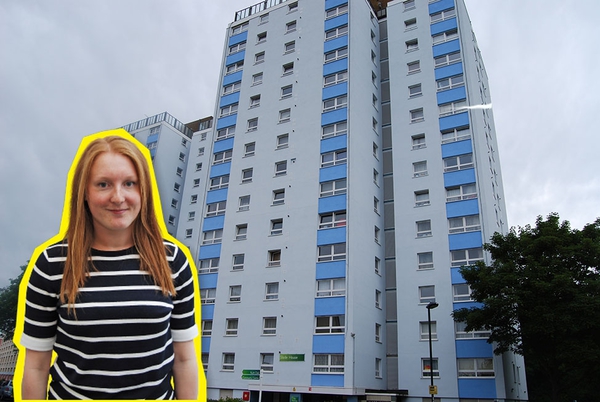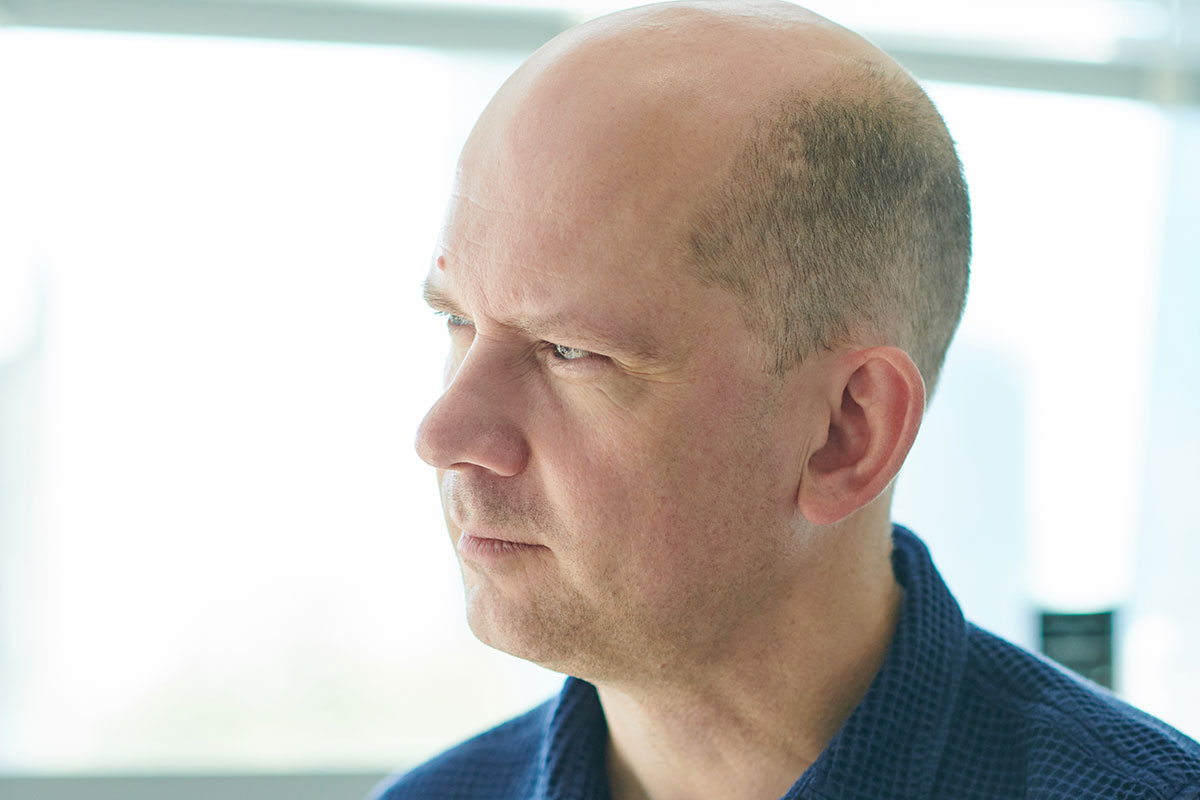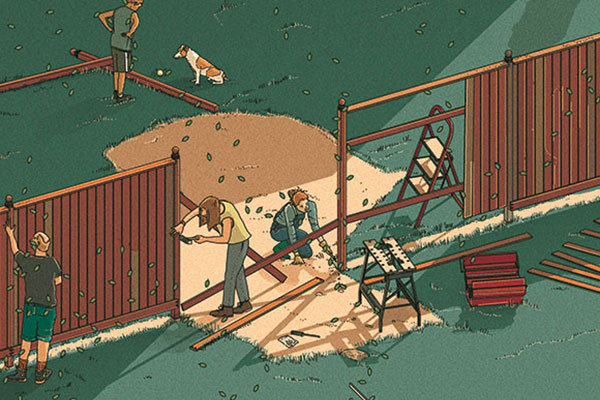You are viewing 1 of your 1 free articles
Restorative justice in housing
How do you make sure disagreements between neighbours don’t get out of hand? Simon Brandon travels to the West Midlands to find out how two housing associations are using restorative justice to prevent anti-social behaviour. Illustration by Douglas Miller
It all started with a demob-happy teenager and a pile of schoolbooks.
When 17-year-old Modou Keita finished his studies last summer, he decided to mark the occasion by setting fire to his schoolbooks in the Coventry garden of the home he shares with his mother, Kaddy, and his two younger sisters. But a strong wind caused the fire to spread. As well as setting a tree in his own garden alight, Modou’s bonfire damaged a wooden fence and garden shed belonging to his family’s neighbour, 65-year-old Angela Cooper, who was on holiday at the time.
“Four neighbours rang the fire brigade,” says Ms Cooper. “All they heard was a bang and a whoosh. The tree must have been 50 feet tall – it just went up.”
Ms Cooper’s daughter rang her to tell her what had happened. “I had saved for a while to get the fencing done – initially I was very angry,” she recalls. “I didn’t know whether to call the police, but I didn’t want to take that to Kaddy’s door… Her son had just left school and I didn’t want him to end up with a criminal record.”
Instead, Ms Cooper – who, like her next-door neighbours, is a tenant of WM Housing Group’s 18,000-home subsidiary Whitefriars Housing – rang her neighbourhood officer. The officer referred the case to a newly established pilot – a three-way partnership between Whitefriars, Coventry City Council and West Midlands Police and Crime Commissioner (PCC), which has been trialling an approach to dispute resolution called restorative justice.
Definitions of restorative justice differ depending on who you ask (see box: What does restorative justice mean?), but at its core is a meeting between two parties – one of whom must, crucially, accept they are at fault.
“The prerequisite for a restorative justice meeting is that the harmer, as we call it, takes responsibility for their behaviour,” says Jeannette Brown, a director at Restorative Approaches in Housing, a consultancy not involved with this pilot but which provides a conflict resolution service to social landlords. “They might not understand that their behaviour causes upset or harm to their neighbour. It’s in the meeting where that becomes apparent to them.”
As with mediation, the conversation in each meeting is structured and the participants are guided through it by a trained facilitator. The difference in the restorative justice approach lies in the harmer’s admission of responsibility.
"The difference in the restorative justice approach lies in the harmer’s admission of responsibility."
“People can’t do it themselves. At so many meetings we have facilitated, the neighbours say they’ve tried to resolve things over the garden fence but it just turns into a slanging match,” says Ms Brown. “And that’s because they don’t have a structure to follow. The structure works.”
Stephen Williams is restorative justice co-ordinator at Whitefriars. The local PCC, which is funding the full £73,000 cost of the pilot, approached Whitefriars and provided Mr Williams’ training. David Jamieson, the West Midlands PCC, says restorative justice is an effective response to anti-social behaviour (ASB), and says his office will be extending the service across the whole of the region starting in the summer (at present, it only covers Coventry and Birmingham).
The dispute between Ms Cooper and Ms Keita was one of the first cases referred to Mr Williams once his training was complete. Since the pilot began, around a dozen of the 58 cases that have been referred to him have ended in a meeting and a successful resolution. Some people choose not to participate in the process, which is voluntary. Others might not want to admit responsibility, while others simply move away, Mr Williams says. But those successes are of enormous value, and not just to the neighbours facing each other across the table.
Mr Williams calls restorative justice “another tool for us to use in sustaining tenancies”. He adds: “That is key for us as a landlord. We can try and find a positive outcome without one of the two parties losing their tenancy, either because they’ve moved out because of the ASB, or – worst case – someone gets evicted.”
The restorative justice approach can help to end neighbour disagreements before they escalate, he adds. And if a community is tight knit, as Mr Williams says many of those on his patch are, that rot can easily spread.
“We have been able to prevent neighbours from becoming embroiled in bigger conflicts." - Nigel Collumbell, Midland Heart
If the dispute between Ms Cooper and Ms Keita, who had been friends before their disagreement, hadn’t been resolved quickly, it might well have spoiled their relationship permanently. What turned out to be a cultural difference created a gap in understanding that wasn’t clear to either party until they sat down and talked it all through.
“I was quite annoyed because this had happened on the Friday and no one came round until the following Tuesday to apologise,” says Ms Cooper. “Kaddy – the mum – came. And that annoyed me more than the actual damage. He [Modou, Ms Keita’s son] had damaged something – the first thing you do is say sorry.”
But Ms Keita, who was born in The Gambia, had been brought up to take a different approach. “In Africa, what we know is that because I am the one who raised my son, then I should go and apologise to Angela,” she says. “But we came to understand that places are different. I didn’t know that Angela would be angry because my son didn’t come to apologise. I liked the meeting, because if I hadn’t gone there I would not have come to know about that.”
The sit-down gave them both a chance to explain how they felt and to understand each other a little better – and because Modou also attended the meeting, Ms Cooper was able to explain to him the consequences of his actions.
“I don’t think he realised what he had done, and I was able to explain to him how it made me feel,” Ms Cooper says. “You could see the look on his face during the meeting, and it was one of pure shame.” Modou agreed to pay the £80 cost of replacing the fence himself, in instalments.
The meetings usually last an hour or two, but what happens during that short time can be extremely powerful. “That change in the room from the beginning of a meeting when they don’t want to look at each other, to the end when they can be hugging and offering each other lifts home – that is the most satisfying part of [working in] ASB,” says Ms Brown. “So many people say, ‘We’ve spoken for two hours and have learned so much about each other – we should have done this years ago’.”
That is almost exactly how the meeting in Coventry ended. “We sorted everything out there,” says Ms Keita. “At the end Angela was chatting with my son – ‘When are you starting university?’ – a nice, family sort of chat. We shared a car home. ‘Don’t worry, Kaddy, we can go home together.’ I cried when she said that.”
What does restorative justice mean?
The principle is easy enough to grasp, but pinning down a single definition of restorative justice turns out to be a little trickier.
“One of the problems with restorative practice is the whole idea of the word restore,” says Chris Straker, interim chief executive at the Restorative Justice Council.
“What are you restoring people back to? You’re trying to restore relationships between people… It’s difficult because maybe there wasn’t a relationship to start with! It’s a complex definition that people can get lost in.”
The government uses a definition based on the work of criminologist John Braithwaite, who in 2004 described restorative justice as a process in which everyone affected by an injustice can discuss how they have been affected, and to decide what to do to repair the harm.
“With crime, restorative justice is about the idea that because crime hurts, justice should heal,” he wrote. “It follows that conversations with those who have been hurt and with those who have afflicted the harm must be central to the process.”
The pilot in Coventry has been a success so far. Phone calls about neighbour disputes to the police and the association have decreased since it began, says Mr Williams.
The West Midlands PCC has been working on and funding a similar project with another West Midlands housing provider, Midland Heart, since 2015. The team there now take on around 100 cases annually.
“By bringing everyone together in one room we have seen really positive outcomes… and by addressing things early we have been able to prevent neighbours from becoming embroiled in bigger conflicts.”
“By bringing everyone together in one room we have seen really positive outcomes… and by addressing things early we have been able to prevent neighbours from becoming embroiled in bigger conflicts,” says Nigel Collumbell, director of housing management at Midland Heart. Funding for restorative justice from the PCC might not last forever, however.
“We have understood for some time that the model of annual funding grants from the PCC was unlikely to be sustainable,” says Mr Collumbell, adding that over the past two years, Midland Heart has been building its own in-house expertise to ensure it can continue offering this service in ASB cases.
“Do it, and get involved,” he advises his colleagues in the sector. “We would like to see this approach being the first step rather than a last resort. If more housing associations use this approach and share their success, we are hopeful that it will become more mainstream.”
It would mean more happy neighbours, too – like Ms Cooper and Ms Keita, who are good friends once again. “I hope it keeps going, because it’s going to help a lot of people,” says Ms Cooper.
Her neighbour is just as positive. “With the help of Whitefriars, we all sat together and talked nicely. We all had peace of mind and that brought a lot of understanding between us,” says Ms Keita. “We hold each other more tightly now than we did before, believe me.”














